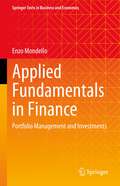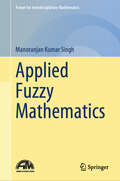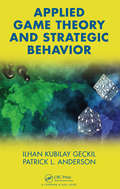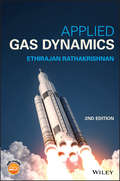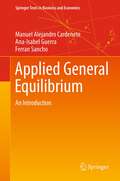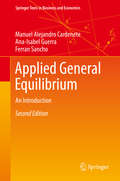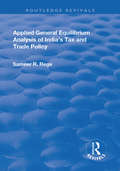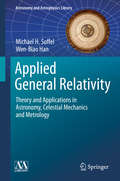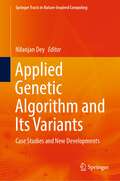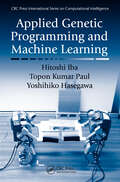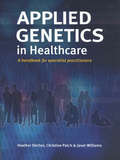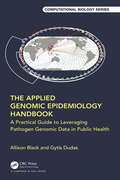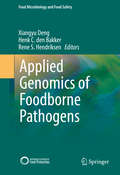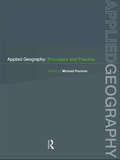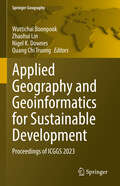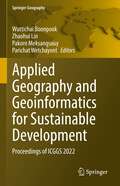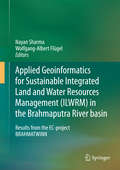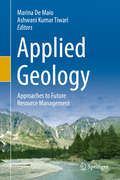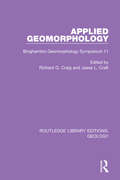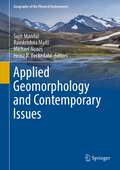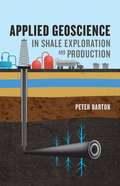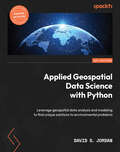- Table View
- List View
Applied Fundamentals in Finance: Portfolio Management and Investments (Springer Texts in Business and Economics)
by Enzo MondelloThis textbook provides a comprehensive introduction to portfolio management and investments. Focusing on four core areas – portfolio management, equities, bonds, and derivatives – it is primarily intended for undergraduate and graduate students alike. However, it will also benefit practitioners working in the fields of financial analysis and portfolio management and professionals who aspire to such professional activities in the financial industry. To ensure its high practical relevance, the book includes a host of case studies and examples from real-world practice, mainly from the German and Swiss financial markets. Additionally, the book shows how to implement the models in Microsoft Excel.
Applied Fuzzy Mathematics (Forum for Interdisciplinary Mathematics)
by Manoranjan Kumar SinghThis comprehensive introductory textbook is designed for undergraduate mathematics students who are interested in gaining an in-depth understanding of fuzzy mathematics and its applications. The book covers a wide range of topics, including fuzzy linear equations, fuzzy graphs, fuzzy measures, fuzzy logic, fuzzy topological spaces, fuzzy subgroups, as well as applications of fuzzy mathematics in various other fields. While readers are assumed to be familiar with the concept of fuzzy sets, the book maintains a clear and straightforward approach that makes it easy to follow for students at any level of proficiency. The advanced content is presented in an insightful and accessible manner, empowering students to apply the concepts they learn to real-world problems and applications. Enriched with over 105 solved examples, 133 challenging problems, 185 multiple-choice questions, and 150 true/false statements, this book is an ideal tool for beginners seeking to gain a solid foundation in fuzzy mathematics and its applications. Whether you are studying independently or as part of a classroom setting, this book provides a valuable resource that will help you achieve your goals.
Applied Game Theory and Strategic Behavior
by Ilhan K. Geckil Patrick L. AndersonUseful Tools to Help Solve Decision Making ProblemsApplied Game Theory and Strategic Behavior demonstrates the use of various game theory techniques to address practical business, economic, legal, and public policy issues. It also illustrates the benefits of employing strategic thinking that incorporates the uncertainty surrounding the behavior of
Applied Gas Dynamics
by Ethirajan RathakrishnanA revised edition to applied gas dynamics with exclusive coverage on jets and additional sets of problems and examples The revised and updated second edition of Applied Gas Dynamics offers an authoritative guide to the science of gas dynamics. Written by a noted expert on the topic, the text contains a comprehensive review of the topic; from a definition of the subject, to the three essential processes of this science: the isentropic process, shock and expansion process, and Fanno and Rayleigh flows. In this revised edition, there are additional worked examples that highlight many concepts, including moving shocks, and a section on critical Mach number is included that helps to illuminate the concept. The second edition also contains new exercise problems with the answers added. In addition, the information on ram jets is expanded with helpful worked examples. It explores the entire spectrum of the ram jet theory and includes a set of exercise problems to aid in the understanding of the theory presented. This important text: Includes a wealth of new solved examples that describe the features involved in the design of gas dynamic devices Contains a chapter on jets; this is the first textbook material available on high-speed jets Offers comprehensive and simultaneous coverage of both the theory and application Includes additional information designed to help with an understanding of the material covered Written for graduate students and advanced undergraduates in aerospace engineering and mechanical engineering, Applied Gas Dynamics, Second Edition expands on the original edition to include not only the basic information on the science of gas dynamics but also contains information on high-speed jets.
Applied General Equilibrium: An Introduction (Springer Texts in Business and Economics)
by Ana-Isabel Guerra Ferran Sancho Manuel Alejandro CardeneteThis advanced textbook aims at providing a simple but fully operational introduction to applied general equilibrium. General equilibrium is the backbone of modern economic analysis and as such generation after generation of economics students are introduced to it. As an analytical tool in economics, general equilibrium provides one of the most complete views of an economy since it incorporates all economic agents (households, firms, government, foreign sector) in an integrated way that is compatible with microtheory and microdata. The integration of theory and data handling is required for successful modeling but it requires a double ability that is not found in standard books. With this book we aim at filling the gap and provide advanced students with the required tools, from the building of consistent and applicable general equilibrium models to the interpretation of the results that ensue from the adoption of policies. The topics include: model design, model development, computer code examples, calibration and data adjustments, practical policy examples.
Applied General Equilibrium: An Introduction (Springer Texts in Business and Economics)
by Ana-Isabel Guerra Ferran Sancho Manuel Alejandro CardeneteThis advanced textbook provides a straightforward but comprehensive introduction to applied general equilibrium modeling. General equilibrium is the backbone of modern economic analysis, which is why generation after generation of economics students have been introduced to it. As an analytical tool, general equilibrium can provide one of the most complete views of a given economy, as it incorporates all economic agents (households, firms, government and the foreign sector) in an integrated way that explicitly reveals the interplay of economic forces--supply and demand--and the balancing role of prices. Applied general equilibrium goes one step further in modeling, since it entails the integration of microeconomic theory, data handling and computing. This integration is essential for successful empirical modeling, but also involves various abilities that are not found in standard books. This book fills the gap, providing advanced students with the required tools, from the construction of consistent and applicable general equilibrium models to the interpretation of the results that ensue from the adoption of policies. This second edition expands the range of topics covered, including: indispensable general equilibrium theory, step-by-step model design, incremental model extensions, a wealth of sample computer code, procedures for constructing economic databases, database adjustments and database updating algorithms, numerical model calibration, policy strategies and their trade-offs and welfare effects, and a discussion of empirical policy examples.
Applied General Equilibrium Analysis of India's Tax and Trade Policy (Routledge Revivals)
by Sameer R. RegeThis title was first published in 2003. India's tax revenues depend on manufacturing while agriculture and services generate employment. WTO's Uruguay and Doha rounds imply large tariff cuts. This affects the competitiveness of the Indian manufacturing sector and has implications for government deficits. Excessive dependence on indirect taxes and subsidies to regulate markets introduces distortions and is incompatible with free market principles. The book analyses welfare implications of fiscal and trade policies for India. To put the results in perspective, developments in trade theory, public finance and Computable General Equilibrium (CGE) modelling are covered. Theoretical results are juxtaposed with empirical findings from these models. Methodology to construct CGE models is also covered. The trade model covers tariff cuts under various assumptions besides incorporating "new trade theory". As tax reforms and tariff cuts are independent, past tax reforms like MODVAT (MODified VAT) and proposed reforms like VAT, elimination/reduction of subsidies are covered using a separate tax model.
Applied General Relativity: Theory and Applications in Astronomy, Celestial Mechanics and Metrology (Astronomy and Astrophysics Library)
by Michael H. Soffel Wen-Biao HanIn the late 20th and beginning 21st century high-precision astronomy, positioning and metrology strongly rely on general relativity. Supported by exercises and solutions this book offers graduate students and researchers entering those fields a self-contained and exhaustive but accessible treatment of applied general relativity. The book is written in a homogenous (graduate level textbook) style allowing the reader to understand the arguments step by step. It first introduces the mathematical and theoretical foundations of gravity theory and then concentrates on its general relativistic applications: clock rates, clock sychronization, establishment of time scales, astronomical references frames, relativistic astrometry, celestial mechanics and metrology. The authors present up-to-date relativistic models for applied techniques such as Satellite LASER Ranging (SLR), Lunar LASER Ranging (LLR), Globale Navigation Satellite Systems (GNSS), Very Large Baseline Interferometry (VLBI), radar measurements, gyroscopes and pulsar timing. A list of acronyms helps the reader keep an overview and a mathematical appendix provides required functions and terms.
Applied Generative AI for Beginners: Practical Knowledge on Diffusion Models, ChatGPT, and Other LLMs
by Akshay Kulkarni Adarsha Shivananda Anoosh Kulkarni Dilip GudivadaThis book provides a deep dive into the world of generative AI, covering everything from the basics of neural networks to the intricacies of large language models like ChatGPT and Google Bard. It serves as a one-stop resource for anyone interested in understanding and applying this transformative technology and is particularly aimed at those just getting started with generative AI. Applied Generative AI for Beginners is structured around detailed chapters that will guide you from foundational knowledge to practical implementation. It starts with an introduction to generative AI and its current landscape, followed by an exploration of how the evolution of neural networks led to the development of large language models. The book then delves into specific architectures like ChatGPT and Google Bard, offering hands-on demonstrations for implementation using tools like Sklearn. You’ll also gain insight into the strategic aspects of implementing generative AI in an enterprise setting, with the authors covering crucial topics such as LLMOps, technology stack selection, and in-context learning. The latter part of the book explores generative AI for images and provides industry-specific use cases, making it a comprehensive guide for practical application in various domains. Whether you're a data scientist looking to implement advanced models, a business leader aiming to leverage AI for enterprise growth, or an academic interested in cutting-edge advancements, this book offers a concise yet thorough guide to mastering generative AI, balancing theoretical knowledge with practical insights. What You Will Learn Gain a solid understanding of generative AI, starting from the basics of neural networks and progressing to complex architectures like ChatGPT and Google BardImplement large language models using Sklearn, complete with code examples and best practices for real-world applicationLearn how to integrate LLM’s in enterprises, including aspects like LLMOps and technology stack selectionUnderstand how generative AI can be applied across various industries, from healthcare and marketing to legal compliance through detailed use cases and actionable insights Who This Book Is For Data scientists, AI practitioners, Researchers and software engineers interested in generative AI and LLMs.
Applied Genetic Algorithm and Its Variants: Case Studies and New Developments (Springer Tracts in Nature-Inspired Computing)
by Nilanjan DeyThis book provides fundamental concepts related to various types of genetic algorithms and practical applications in various domains such as medical imaging, manufacturing, and engineering design. The book discusses genetic algorithms which are used to solve a variety of optimization problems. The genetic algorithms are demonstrated to offer reliable search in complex spaces. The book presents high-quality research work by academics and researchers which is useful for young researchers and students.
Applied Genetic Programming and Machine Learning
by Hitoshi Iba Yoshihiko Hasegawa Topon Kumar PaulWhat do financial data prediction, day-trading rule development, and bio-marker selection have in common? They are just a few of the tasks that could potentially be resolved with genetic programming and machine learning techniques. Written by leaders in this field, Applied Genetic Programming and Machine Learning delineates the extension of Genetic
Applied Genetics in Healthcare: A Handbook For Specialist Practitioners
by Heather Skirton Christine Patch Janet WilliamsIncreasingly, genomics is having an impact on mainstream healthcare. All health professionals will now be required to understand basic genetic concepts, but the depth of knowledge required will vary according to the role of the practitioner, and the setting in which he or she works. Following the success of Genetics for Healthcare Professionals by Skirton and Patch, which was written for practitioners at foundation level, Applied Genetics in Healthcare approaches the issues of genetic healthcare at a more advanced level and is primarily intended as a handbook for those training or working as genetic specialists. However, the book will also be a useful resource for practitioners who specialize in particular fields of healthcare that require knowledge of genetics in specific topics. Those experienced in genetic healthcare will find the book to be a valuable handbook and a source of references for wider reading. All of the authors have worked extensively in the field of genetic healthcare and have used their experience in both genetics nursing and genetics counseling to create a working handbook that is rooted in clinical practice.
The Applied Genomic Epidemiology Handbook: A Practical Guide to Leveraging Pathogen Genomic Data in Public Health (Chapman & Hall/CRC Computational Biology Series)
by Allison Black Gytis DudasThe Applied Genomic Epidemiology Handbook: A Practical Guide to Leveraging Pathogen Genomic Data in Public Health provides rationale, theory, and implementation guidance to help public health practitioners incorporate pathogen genomic data analysis into their investigations. During the SARS-CoV-2 pandemic, viral whole genome sequences were generated, analyzed, and shared at an unprecedented scale. This wealth of data posed both tremendous opportunities and challenges; the data could be used to support varied parts of the public health response but could be hard for much of the public health workforce to analyze and interpret, given a historical lack of experience working with pathogen genomic data.This book addresses that gap. Structured into eight wide-ranging chapters, this book describes how the overlapping timescales of pathogen evolution and infection transmission enable exploration of epidemiologic dynamics from pathogen sequence data. Different approaches to sampling and genomic data inclusion are presented for different types of epidemiologic investigations. To support epidemiologists in diving into pathogen genomic data analysis, this book also introduces the analytic tools and approaches that are readily used in public health departments and presents case studies to show step-by-step how genomic data are used and evaluated in disease investigations.Despite the breadth of scientific literature that uses pathogen genomic data to investigate disease dynamics, there remains little practical guidance to help applied epidemiologists build their ability to explore epidemiologic questions with pathogen genomic data. This handbook was written to serve as that guide. Including case studies, common methods, and software tools, this book will be of great interest to public health microbiologists or lab directors, bioinformaticians, epidemiologists, health officers, academics, as well as students working in a public health context.
Applied Genomics of Foodborne Pathogens (Food Microbiology and Food Safety)
by Xiangyu Deng Henk C. Bakker Rene S. HendriksenThis book provides a timely and thorough snapshot into the emerging and fast evolving area of applied genomics of foodborne pathogens. Driven by the drastic advance of whole genome shot gun sequencing (WGS) technologies, genomics applications are becoming increasingly valuable and even essential in studying, surveying and controlling foodborne microbial pathogens. The vast opportunities brought by this trend are often at odds with the lack of bioinformatics know-how among food safety and public health professionals, since such expertise is not part of a typical food microbiology curriculum and skill set. Further complicating the challenge is the large and ever evolving body of bioinformatics tools that can obfuscate newcomers to this area. Although reviews, tutorials and books are not in short supply in the fields of bioinformatics and genomics, until now there has not been a comprehensive and customized source of information designed for and accessible to microbiologists interested in applying cutting-edge genomics in food safety and public health research. This book fills this void with a well-selected collection of topics, case studies, and bioinformatics tools contributed by experts at the forefront of foodborne pathogen genomics research.
Applied Geography: Principles and Practice
by Michael PacioneApplied Geography offers an invaluable introduction to useful research in physical, environmental and human geography and provides a new focus and reference point for investigating and understanding problem-orientated research. Forty-nine leading experts in the field introduce and explore research which crosses the traditional boundary between physical and human geography. A wide range of key issues and contemporary debates are within the books main sections, which cover: natural and environmental hazards environmental change and management challenges of the human environment techniques of spatial analysis Applied geography is the application of geographic knowledge and skills to identify the nature and causes of social, economic and environmental problems and inform policies which lead to their resolution.
Applied Geography and Geoinformatics for Sustainable Development: Proceedings of ICGGS 2023 (Springer Geography)
by Wuttichai Boonpook Zhaohui Lin Nigel K. Downes Quang Chi TruongThis volume presents the proceedings of the 3rd International Conference of Geography and Geoinformatics for Sustainable Development (ICGGS), held in Can Tho, Vietnam, November 30 - December 2, 2023. It focuses on cutting-edge applications of geoinformatics for sustainable development, including using artificial intelligence and machine learning in environmental monitoring, integrating the Internet of Things (IoT) for real-time data collection, and advanced techniques in remote sensing for urban development and climate change adaptation. Additionally, this volume features case studies predominantly from Vietnam and Thailand, providing fresh insights into regional challenges and innovative solutions for sustainable resource management.
Applied Geography and Geoinformatics for Sustainable Development: Proceedings of ICGGS 2022 (Springer Geography)
by Wuttichai Boonpook Zhaohui Lin Pakorn Meksangsouy Parichat WetchayontThis volume presents the proceedings of the 2nd International Conference of Geography and Geoinformatics for Sustainable Development (ICGGS), held in Phuket, Thailand, April 7-8, 2022. The collection focuses on the importance of spatial thinking and planning by applying geography concepts and geospatial technology innovations in solving global problems such as environmental degradation, urban pollution, and climate change. The proceedings consist of case studies on wide-ranging spatial issues in developing countries, addressing challenges in mainstreaming sustainable development paradigms into their economies to improve natural resource and environmental management. One of the main goals of the volume is to share and exchange different points of view regarding global, regional, and local spatial issues and how to use geography and geoinformatics for building resilience in multiple sectors, e.g., water, ecosystems, agriculture, and health. It offers the opportunity to learn about how geospatial concepts and technologies can contribute to environmental sustainability, while advancing education and research related to geography and geoinformatics. It will be a useful resource for students and researchers to initiate research ideas related to geospatial topics in regional and local scales.
Applied Geoinformatics for Sustainable Integrated Land and Water Resources Management (ILWRM) in the Brahmaputra River basin: Results from the EC-project BRAHMATWINN
by Nayan Sharma Wolfgang-Albert FlügelThe central theme of this book is focused on the analyses and the results which emerged from the international research project BRAHMATWINN sponsored by European Commission (EC) and conducted during 2006 - 2009. The book highlights the achievements of BRAHMATWINN to carry out a harmonised integrated water resources management (IWRM) approach as addressed by the European Water Initiative (EWI) in headwater river systems of alpine mountain massifs. The latter are already impacted from climate change, and the BRAHMATWINN project established transfer of professional IWRM expertise, approaches and tools based on case studies carried out in twinning European and Asian river basins. The project addresses all important IWRM issues in a balanced way, including conflict resolution in the trans- boundary Danube and Brahmaputra River Basins in Europe and South Asia respectively. This book will be useful to researchers, professionals, managers and decision makers associated with study and application of sustainable integrated land and water resources management (ILWRM) in the backdrop of climate change.
Applied Geology: Approaches to Future Resource Management
by Marina De Maio Ashwani Kumar TiwariThis book includes a careful selection of significant contributions from international experts that were presented at the 6th AIGA Conference “Applied Geology: Approaches to Future Resource Management” that was held in the Courmayeur, Aosta Valley, Italy, from 27 - 29 June 2018. The following 7 areas are the main themes covered in this volume: · Applied Geology · Hydrogeology · Geological Exploration (underground) · Slope Instability, · Natural Hazards, Risk Assessment and Management, · Geo-resources and Sustainable Development · Application of Remote Sensing and Geographical Information Systems (GIS) The authors, from academia, research and industry present the latest state of the practice, new technologies, innovative methods and sustainable management in the field of Applied and Environmental Geology. This carefully edited work will be of value to academia, professionals, scientists and decision makers.
Applied Geomorphology: Binghamton Geomorphology Symposium 11 (Routledge Library Editions: Geology #3)
by Richard G. Craig and Jesse L. CraftThis book, first published in 1982, forms the proceedings volume of the 11th Binghamton Geomorphology Symposium. Chapters cover various coastline phenomena, glacial and periglacial processes, carbonate terrains, and specific applications of geomorphic knowledge and techniques.
Applied Geomorphology and Contemporary Issues (Geography of the Physical Environment)
by Sujit Mandal Ramkrishna Maiti Michael Nones Heinz R. BeckedahlThe edited book deals with climate change and its response to river system which is one of the most burning issues of the Global environment. Due to urbanization and industrialization land degradation and resource depletion are happening and promoting livelihood challenges in the world which is reflected in the book too. The book addresses the construction of dams over large rivers and its possible consequences in the environment. Changes of the hydrology and sedimentology are to be addressed in the book. The climate change phenomena and associated geomorphic hazards and contemporary environmental issues such as sea level rise, coastal flood, drought, wind erosion, flood, soil erosion, landslide, depletion of ground water, coastal erosion etc. are elaborated in the book with suitable methods and techniques. So this edited book will contribute a lot to general to particular filed of studies and will help to geographers, geomorphologists, environmentalists, planners, policy makers and developers for studies and promoting regional plans and development.
Applied Geophysics
by W. M. Telford L. P. Geldart R. E. SheriffThis is the completely revised and updated version of the popular and highly regarded textbook, Applied Geophysics. It describes the physical methods involved in exploration for hydrocarbons and minerals, which include gravity, magnetic, seismic, electrical, electromagnetic, radioactivity, and well-logging methods. All aspects of these methods are described, including basic theory, field equipment, techniques of data acquisition, data processing and interpretation, with the objective of locating commercial deposits of minerals, oil, and gas and determining their extent. In the fourteen years or so since the first edition of Applied Geophysics, many changes have taken place in this field, mainly as the result of new techniques, better instrumentation, and increased use of computers in the field and in the interpretation of data. The authors describe these changes in considerable detail, including improved methods of solving the inverse problem, specialized seismic methods, magnetotellurics as a practical exploration method, time-domain electromagnetic methods, increased use of gamma-ray spectrometers, and improved well-logging methods and interpretation.
Applied Geoscience in Shale Exploration and Production
by Peter BartokSince the year 2000, unconventional shale plays have contributed greatly to the global oil and gas supply, particularly in the United States. Understanding and managing these resources requires a unique understanding about the geology, geophysics, rock physics, and rock mechanics of each reservoir in a seamless interdisciplinary approach. Equally important, advanced technologies in seismic and microseismic processing enable professionals to map and identify the hydrocarbon resource and establish the optimum pathways for production.
Applied Geospatial Data Science with Python: Leverage geospatial data analysis and modeling to find unique solutions to environmental problems
by David S. JordanIntelligently connect data points and gain a deeper understanding of environmental problems through hands-on Geospatial Data Science case studies written in PythonThe book includes colored images of important conceptsKey FeaturesLearn how to integrate spatial data and spatial thinking into traditional data science workflowsDevelop a spatial perspective and learn to avoid common pitfalls along the wayGain expertise through practical case studies applicable in a variety of industries with code samples that can be reproduced and expandedBook DescriptionData scientists, when presented with a myriad of data, can often lose sight of how to present geospatial analyses in a meaningful way so that it makes sense to everyone. Using Python to visualize data helps stakeholders in less technical roles to understand the problem and seek solutions. The goal of this book is to help data scientists and GIS professionals learn and implement geospatial data science workflows using Python.Throughout this book, you'll uncover numerous geospatial Python libraries with which you can develop end-to-end spatial data science workflows. You'll learn how to read, process, and manipulate spatial data effectively. With data in hand, you'll move on to crafting spatial data visualizations to better understand and tell the story of your data through static and dynamic mapping applications. As you progress through the book, you'll find yourself developing geospatial AI and ML models focused on clustering, regression, and optimization. The use cases can be leveraged as building blocks for more advanced work in a variety of industries.By the end of the book, you'll be able to tackle random data, find meaningful correlations, and make geospatial data models.What you will learnUnderstand the fundamentals needed to work with geospatial dataTransition from tabular to geo-enabled data in your workflowsDevelop an introductory portfolio of spatial data science work using PythonGain hands-on skills with case studies relevant to different industriesDiscover best practices focusing on geospatial data to bring a positive change in your environmentExplore solving use cases, such as traveling salesperson and vehicle routing problemsWho this book is forThis book is for you if you are a data scientist seeking to incorporate geospatial thinking into your workflows or a GIS professional seeking to incorporate data science methods into yours. You'll need to have a foundational knowledge of Python for data analysis and/or data science.
Applied Geostatistics With Sgems: A User's Guide
by Nicolas Remy Alexandre Boucher Jianbing WuThe Stanford Geostatistical Modeling Software (SGeMS) is an open-source computer package for solving problems involving spatially related variables. It provides geostatistics practitioners with a user-friendly interface, an interactive 3-D visualization, and a wide selection of algorithms. This practical book provides a step-by-step guide to using SGeMS algorithms. It explains the underlying theory, demonstrates their implementation, discusses their potential limitations, and helps the user make an informed decision about the choice of one algorithm over another. Users can complete complex tasks using the embedded scripting language, and new algorithms can be developed and integrated through the SGeMS plug-in mechanism. SGeMS is the first software to provide algorithms for multiple-point statistics, and the book presents an up-to-date discussion of the corresponding theory and applications. Incorporating a CD-ROM with SGeMS software, this book is an essential user-guide for Earth Science graduates and researchers, as well as practitioners of environmental, mining and petroleum engineering.
